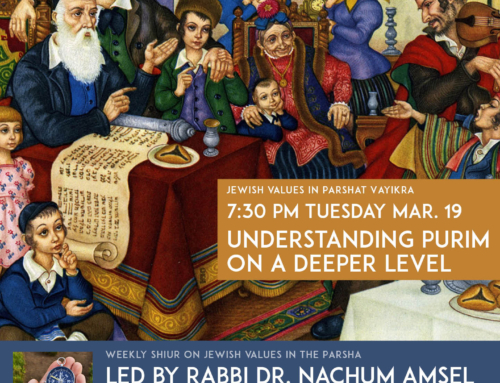Before making Aliyah, I could not have understood the vast differences between life in the “old country” and our new home in Israel. I knew that living in Israel meant we’d have the “feeling we’re not in Kansas anymore”, but after 16 years, I keep on seeing more and more differences that I did not see when we first arrived.
While living abroad, I did not fully appreciate the incredibly strong bond that exists between Jewish Israelis, the land and our religion. We live and breathe Judaism here and are reminded of our history almost every single day.
A walk in most Israeli cities takes you through streets named after leaders, scholars, pioneers, authors, artists, songwriters and those who helped the Jewish people. Just walking to the corner makolet can be a lesson in ancient and modern history. Everyone in Israel is reminded of upcoming Jewish holidays, when they see stores selling Hamantaschen, Matzot or Sukka decorations. You know the season not only by the changes in weather (hot and hotter), but the holidays that take us from month to month. The pace of the country slows as we approach holidays, when the service technician says “after the chagim”.
We are reminded as the music on the radio changes to reflect the holidays and suddenly goes somber and muted when we commemorate Yom HaShoah or Yom HaZikaron. Judaism is very much a part of everyday life here. It is not like seeing Christmas trees in the US. Even Jews who choose not to practice are bound up with Judaism and Jewish history. Stats indicate that 42 percent of Jewish Israelis are secular, yet a whopping 93 percent of Israeli Jews attend a Passover seder and over 60 percent fast on Yom Kippur.
A few years ago we moved to Ashkelon, a seaside city that has a history, which predates most European settlements. Ashkelon has been home to people during the Neolithic period, Canaanite, Israelite, Philistine, Persian, Hellenist and Roman, Byzantine, Islamic, Crusader, Ayyubid, Mamluk, Ottoman and finally us, again. Underneath the modern city of Ashkelon are the remnants of those that lived here before us. When we purchased our apartment there was a note attached to our property registration letting us know that there were Byzantine relics beneath our apartment complex.
Ashkelon was captured by Joshua when the Israelites returned from Egypt, but became one of the five powerful Philistine cities. The Bible reminds us of the numerous clashes between the Israelites and the Philistines. We are still fighting those battles, but with another enemy now. While the situation has been calmer in the last year, since the May 2021 war with Gaza, we still have reminders of our terrorist neighbors to the south, who choose to launch rockets at all hours of the night, sending us to our Mamads (for those that have them) or other safer areas, such as stairwells or basement shelters.
But on most summer days, you can see throngs of people, local and tourists, Jews, Christians and Muslims, coming to Ashkelon’s beaches to swim, surf or to watch the gorgeous sunsets. Most are oblivious to the history that lies beneath their feet.
 For many Jews in Ashkelon, there is an annual reminder of our collective history. For the three weeks that start with the fast day of the 17th of Tammuz and end with the fast of Tisha B’Av, the country observes a period of mourning for the many calamities that happened to the Jewish people, including the destruction of the first and second temples and the resultant exile to the diaspora.
For many Jews in Ashkelon, there is an annual reminder of our collective history. For the three weeks that start with the fast day of the 17th of Tammuz and end with the fast of Tisha B’Av, the country observes a period of mourning for the many calamities that happened to the Jewish people, including the destruction of the first and second temples and the resultant exile to the diaspora.
These three weeks are considered an inauspicious time for the Jewish people and a time of caution. Depending on the approach to observance, many men do not shave, couples do not get married, many people avoid business deals, do not listen to music and generally avoid dangerous situations, including travel. While some rabbis permit swimming until the Nine Days, it is forbidden in dangerous waters. As a reminder of the dangers that lurk below the surface, the three weeks seems to coincide with the invasion of large jellyfish blooms. While marine biologists offer scientific explanations for the large jellyfish presence (which is not connected to the Three Weeks), the anecdotal evidence has become the standard explanation amongst many locals of the annual invasion and departure.
Despite our strong army and our many military victories, the period of Three Weeks is a reminder of past times when we strayed and fell prey to forces that were stronger than us. One of the most vivid descriptions of our losses is painted in one of the Kinot that is recited on Tisha B’Av. Eli Zion V’Areha is an acrostic composed in the Middle Ages. We don’t know who wrote it, but it has been sung by Jews for hundreds of years. It is recited by the entire congregation and that is why it is so well known. The text compares the pain of our losses to a woman giving birth and a maiden wrapped in sackcloth mourning for the husband of her youth.
Rona Kenan (https://www.ronakenan.com/about-1), a talented Israeli singer-songwriter took the works and melody and recorded it, making one of the most meaningful renditions I have ever heard.
אֱלִי צִיּוֹן וְעָרֶיהָ, כְּמוֹ אִשָּׁה בְּצִירֶיהָ, וְכִבְתוּלָה חֲגוּרַת שַׂק, עַל בַּעַל נְעוּרֶיהָ
Mourn for Zion and her cities, like a woman giving birth, like a maiden wrapped in sack-cloth for the husband of her youth
עֲלֵי אַרְמוֹן אֲשֶׁר נֻטַּשׁ, בְּאַשְׁמַת צֹאן עֲדָרֶיהָ,
Mourn for the palace that was abandoned like a sheep’s negligence of its flock,
וְעַל בִּיאַת מְחָרְפֵי אֵל, בְּתוֹךְ מִקְדַּשׁ חֲדָרֶיהָ.
and for the entry of God’s blasphemers into her holy sanctuary.
עֲלֵי גָלוּת מְשָׁרְתֵי אֵל, נְעִימֵי שִׁיר זְמָרֶיהָ,
Mourn for God’s exiled servants who beautifully sang her songs,
וְעַל דָּמָם אֲשֶׁר שֻׁפַּךְ כְּמוֹ מֵימֵי יְאוֹרֶיהָ.
and for their blood that was spilled like the waters of her rivers.
עֲלֵי הֶגְיוֹן מְחוֹלֶיהָ, אֲשֶׁר דָּמַם בְּעָרֶיהָ,
Mourn for the chatter of her dancers whose silence fills her cities,
וְעַל וַעַד אֲשֶׁר שָׁמַם וּבִטּוּל סַנְהֶדְרֶיהָ.
and for the assembly that was destroyed and the abolition of her Sanhedrin.
עֲלֵי זִבְחֵי תְמִידֶיהָ וּפִדְיוֹנֵי בְּכוֹרֶיהָ,
Mourn for the daily sacrifices and the redemption of her firstborn,
וְעַל חִלּוּל כְּלֵי הֵיכָל וּמִזְבֵּחַ קְטוֹרֶיהָ.
and for the desecration of the Temple vessels and the altar of her incense.
עֲלֵי טַפֵּי מְלָכֶיהָ בְּנֵי דָוִד גְּבִירֶיהָ,
Mourn for the babes of her kings, noble children of David,
וְעַל יָפְיָם אֲשֶׁר חָשַׁךְ בְּעֵת סָרוּ כְּתָרֶיהָ.
and for their beauty that was darkened at the time of the removal of her crowns.
עֲלֵי כָבוֹד אֲשֶׁר גָּלָה בְּעֵת חָרְבַּן דְּבִירֶיהָ,
Mourn for the glory that was dispelled at the time of the destruction of her Holy of Holies,
וְעַל לוֹחֵץ אֲשֶׁר לָחַץ וְשָׂם שַׂקִּים חֲגוֹרֶיהָ:
and for the oppressor who tormented her whilst girding her in sackcloth.
עֲלֵי מַחַץ וְרֹב מַכּוֹת אֲשֶׁר הֻכּוּ נְזִירֶיהָ,
Mourn for the wounds and the many blows that struck her sainted ones,
וְעַל נִפּוּץ אֱלֵי סֶלַע עֲוִילֶיהָ נְעָרֶיהָ.
and for the smashing on the rock of her young children.
עֲלֵי שִׂמְחַת מְשַׂנְאֶיהָ בְּשָׂחְקָם עַל שְׁבָרֶיהָ,
Mourn for the joy of her haters who rejoiced over her downfall,
וְעַל עִנּוּי בְּנֵי חוֹרִין נְדִיבֶיהָ טְהוֹרֶיהָ.
and for the torment of her pure and noble citizens.
עֲלֵי פֶשַׁע אֲשֶׁר עָוְתָה סְלוֹל דֶּרֶךְ אֲשׁוּרֶיהָ,
Mourn for the sins that caused her to deviate from the true path,
וְעַל צִבְאוֹת קְהָלֶיהָ שְׁזוּפֶיהָ שְׁחוֹרֶיהָ.
and for her numerous congregations, which were tarnished and blackened.
עֲלֵי קוֹלוֹת מְחָרְפֶיהָ בְּעֵת רַבּוּ פְגָרֶיהָ,
Mourn for the voices of her abusers as her rising corpses mounted,
וְעַל רִגְשַׁת מְגַדְפֶיהָ בְּתוֹך מִשְׁכַּן חֲצֵרֶיהָ.
and for the jeering mobs within her holy courtyards.
עֲלֵי שִׁמְךָ אֲשֶׁר חֻלַּל בְּפִי קָמֵי מְצֵרֶיהָ,
Mourn for Your name which was desecrated in the mouths of those who stand against her,
וְעַל תַּחַן יְצַוְּחוּ לָךְ קְשׁוֹב וּשְׁמַע אֲמָרֶיהָ.
and for their prayers which they cry out to you, heed and hear her words….
אֱלִי צִיּוֹן וְעָרֶיהָ, כְּמוֹ אִשָּׁה בְּצִירֶיהָ, וְכִבְתוּלָה חֲגוּרַת שַׂק, עַל בַּעַל נְעוּרֶיהָ:
Mourn for Zion and her cities, like a woman giving birth, like a maiden wrapped in sack-cloth for the husband of her youth




